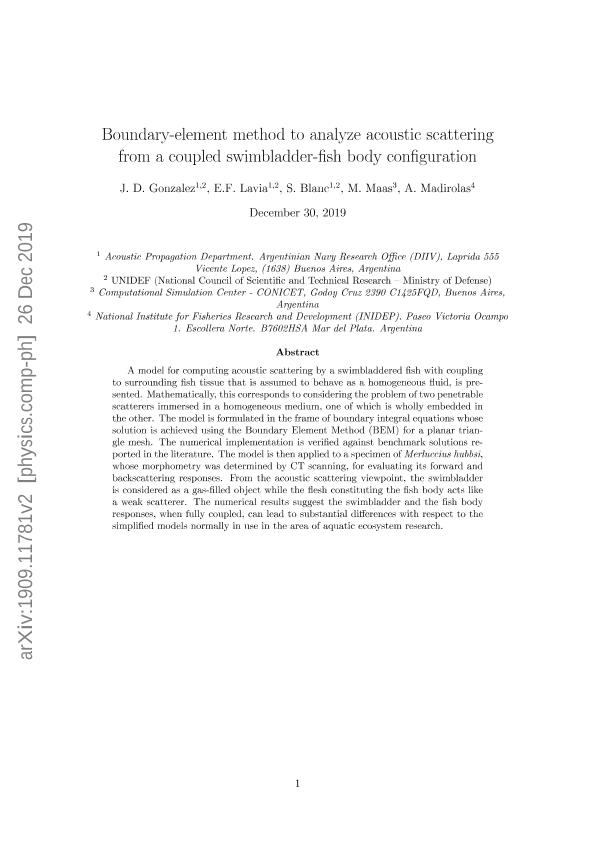Artículo
Boundary element method to analyze acoustic scattering from a coupled swimbladder-fish body configuration
Gonzalez, Juan Domingo ; Lavia, Edmundo; Blanc, Silvia; Maas, Martín Daniel
; Lavia, Edmundo; Blanc, Silvia; Maas, Martín Daniel ; Madirolas, Adrian Osvaldo
; Madirolas, Adrian Osvaldo
 ; Lavia, Edmundo; Blanc, Silvia; Maas, Martín Daniel
; Lavia, Edmundo; Blanc, Silvia; Maas, Martín Daniel ; Madirolas, Adrian Osvaldo
; Madirolas, Adrian Osvaldo
Fecha de publicación:
10/11/2020
Editorial:
Academic Press Ltd - Elsevier Science Ltd
Revista:
Journal of Sound and Vibration
ISSN:
0022-460X
Idioma:
Inglés
Tipo de recurso:
Artículo publicado
Clasificación temática:
Resumen
A model for computing acoustic scattering by swimbladdered fish is presented. The effect of acoustic coupling between the fish tissue and the swimbladder is included. The swimbladder is considered a gas-filled object whereas the fish tissue is assumed to behave as a homogeneous fluid. Mathematically, this corresponds to considering the problem of two penetrable scatterers immersed in a homogeneous medium, one of which is wholly embedded in the other. The model is formulated in the frame of boundary integral equations whose solution is achieved using the Boundary Element Method (BEM) for a planar triangle mesh. The numerical implementation is verified against benchmark solutions reported in the literature. The model is then applied to a specimen of Argentine hake (Merluccius hubbsi), whose morphometry was determined by CT scanning of a frozen sample, for evaluating its forward and backscattering responses. From the acoustic scattering viewpoint, the swimbladder is considered as a gas-filled object while the flesh constituting the fish body acts like a weak scatterer. The numerical results suggest the swimbladder and the fish body responses, when fully coupled, can lead to substantial differences with respect to the simplified models normally in use in the area of aquatic ecosystem research.
Archivos asociados
Licencia
Identificadores
Colecciones
Articulos(SEDE CENTRAL)
Articulos de SEDE CENTRAL
Articulos de SEDE CENTRAL
Citación
Gonzalez, Juan Domingo; Lavia, Edmundo; Blanc, Silvia; Maas, Martín Daniel; Madirolas, Adrian Osvaldo; Boundary element method to analyze acoustic scattering from a coupled swimbladder-fish body configuration; Academic Press Ltd - Elsevier Science Ltd; Journal of Sound and Vibration; 486; 10-11-2020; 1-17
Compartir
Altmétricas



